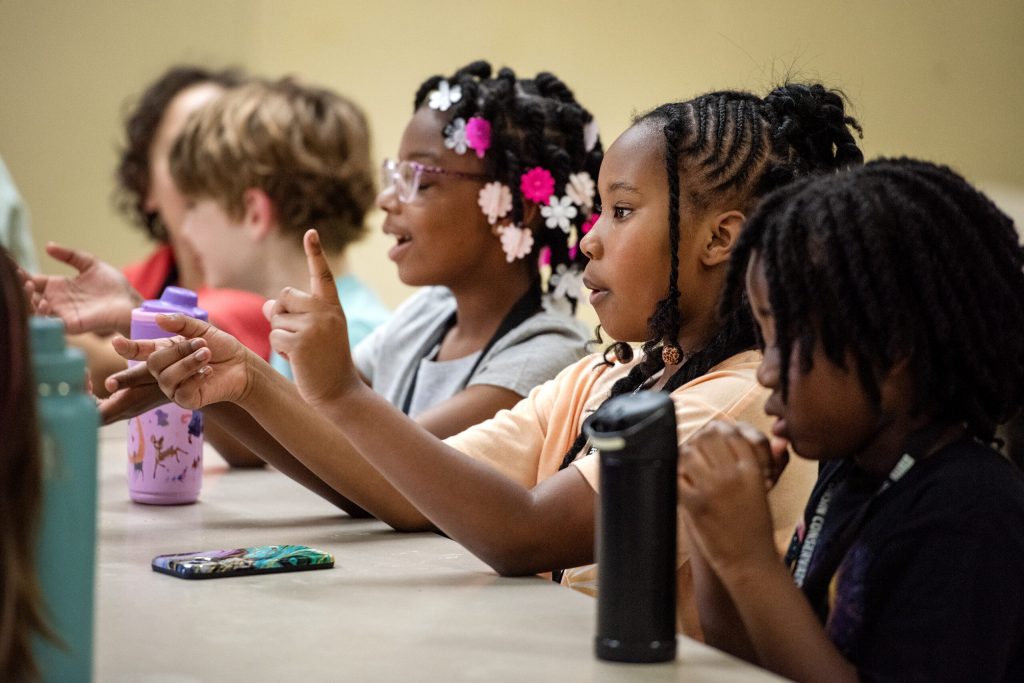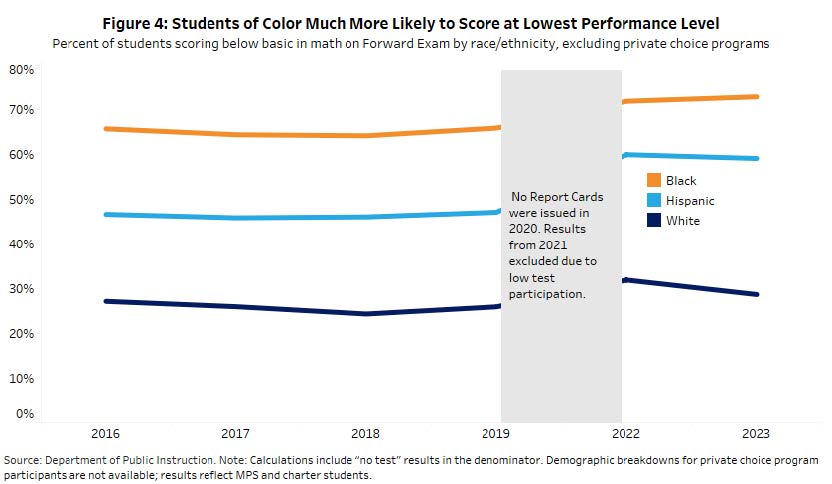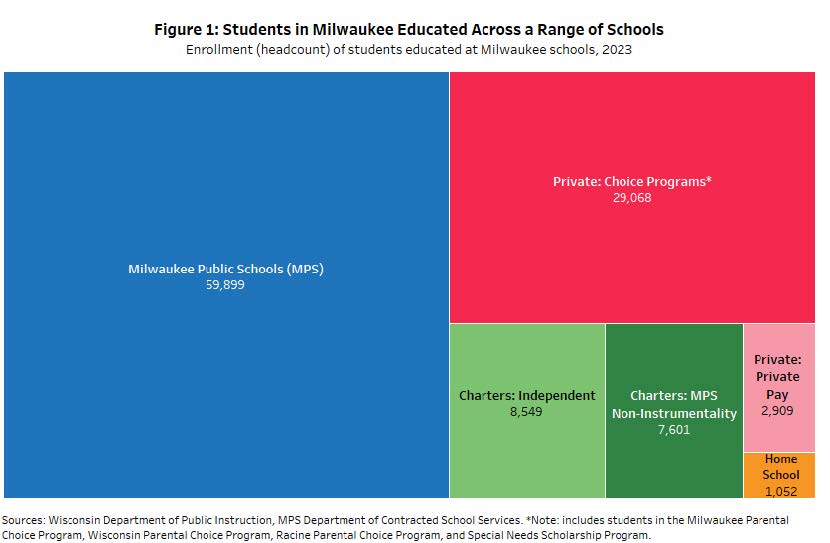Whether Public, Private or Charter, Report Shows Milwaukee Schools Are Often Struggling
Black students continue to perform at levels below their peers

Students participate in choir practice Thursday, June 27, 2024, at Henry David Thoreau Elementary School in Milwaukee, Wis. Angela Major/WPR
Despite Milwaukee parents having multiple education options for their kids, there are only pockets of success stories across the city at both the public and private schools, according to a new report.
Black students, in particular, continue to perform at levels far below their peers in other urban cities, with students in Milwaukee’s public school system and private voucher programs struggling with pandemic recovery and longstanding disparities.
The comprehensive 57-page report released this week by the the Policy Forum looks at the students, financing and performance of Milwaukee’s public and private K-12 schools.
A second report is expected this fall that will look at success stories at schools in Milwaukee and across the country.
The report was funded, in part, by Northwestern Mutual, who paid for co-researcher Robert Rauh. Rauh is the former CEO of Milwaukee College Prep, a private voucher school in the city.
He is now strategic advisor for City Forward Collective. That group, and Northwestern Mutual were strong critics of MPS’s’ $252 million referendum, which narrowly passed in April.
While some variations in school performance exist between sectors and schools, the stark reality is that many Milwaukee students are not able to read or do math at close to grade level.
Wisconsin Policy Forum report
MPS enrollment continues to decline
The forum report also found the total number of school-age children in Milwaukee, and enrollment in MPS, has declined markedly over the last two decades, while enrollment in Milwaukee charter schools and private schools using vouchers through the Milwaukee Parental Choice Program has increased.
Milwaukee Public Schools operated 143 schools in 2023 with a total of 59,899 students. That represented about half of the students served in the city. From 2006 to 2024, enrollment in MPS plummeted by one third.
Meanwhile, charter school enrollments more than doubled during that same time period from 7,323 in 2006 to 15,695 in 2024.
Enrollment in Milwaukee’s private choice schools increased nearly 90 percent since 2006 from 15,864 to 30,103 last school year, according to the report.
Besides parents moving their children from public to private schools, there are fewer children being born.
Based on current birth data, by 2029, the number of first graders in Milwaukee is likely to be between 16 and 22 percent lower than it was in 2023, Shaw said.
Black students least likely to attend highly-ranked schools
Milwaukee was seen as the center of education reform in the 1990s when the Milwaukee Parental Choice Program was created. It was the country’s first initiative to offer publicly funded tuition vouchers for students to attend private schools.
The report found there is little evidence the average Milwaukee child receives a higher quality education today.
“On basically every standardized measure, whether at the state or the national level, Milwaukee has historically and continues to really struggle to systemically educate kids well, particularly our Black children,” Shaw said.
This knowledge should force people to ask what core issues are making it difficult for children to succeed in school and how we set standards for staff and students, Shaw said.
Quinton Klabon, senior research director with the right-leaning Institute for Reforming Government, said the Policy Forum report shows Milwaukee is an outlier, performing at the bottom of its national peers.
But Klabon said it should not be about pitting public schools against private schools.
“It’s parents deciding Milwaukee isn’t worth living in because they can’t find a high-performing school for their children, depopulating our city,” Klabon said. “To grow Milwaukee to a million, we must get serious about expanding the city’s best schools, copying what works in America’s outstanding urban classrooms, and spending money wisely. The greatest chapter in the Cream City’s history can still be written if anybody picks up the pen.”

Milwaukee has the worst race discrepancy in the country between Black and white students. Source: Wisconsin Policy Forum
Nicole Armendariz, spokesperson for MPS, said the voucher school system was created with the promise that it would lift all students, but the report makes it clear it hasn’t.
“Milwaukee Public Schools provides education options for all students when other schools in the city do not. The Wisconsin Policy Forum’s report recognizes that support for children with the highest needs, including special education students and English learners, is not sufficient, and falls almost entirely to the public school system,” Armendariz said.
The Policy Forum was unable to get accurate data on the number of students with disabilities in private choice programs because that data was not submitted to the state.
MPS, charter schools and private choice programs in the city all served at least 90 percent students of color and over 75 percent economically disadvantaged students — some of the highest rates in the state, according to the report.
“As MPS continues to serve the most vulnerable students in Milwaukee, while also providing services to private schools, public school funding continues to erode,” Armendariz said. “It’s time to look outside the boundaries of the city of Milwaukee and to the state level to establish systems that will finally provide the support students need to thrive.”
Absenteeism in Milwaukee worse than other urban districts
Chronic absenteeism has been an issue in school districts across the country since the pandemic. The Policy Forum’s research found Milwaukee students are missing school more than any other urban district in the nation.
While there is not data provided for the voucher schools, Milwaukee Public Schools and Milwaukee charter schools saw chronic absenteeism jump in 2021 and slightly decline in 2022 and 2023.
About 37 percent of students in charter schools are chronically absent. At MPS, 51 percent of students are chronically absent. Nationally, the average is 32 percent.
A student is considered chronically absent when they attend less than 90 percent of school days.
Attendance is an important measure of student engagement and a predictor of future achievement, dropout or late graduation.
“So when we think about what’s even possible to do in schools, usually we start with our kids at least there to be able to benefit from whatever interventions we’re putting in place,” Shaw said. “And that prerequisite for inside school change really is not there right now.”
Report: Despite options, Milwaukee children struggle in both public and private schools was originally published by Wisconsin Public Radio.
If you think stories like this are important, become a member of Urban Milwaukee and help support real, independent journalism. Plus you get some cool added benefits.























A “comprehensive report”… actually a partisan, anti- public education hit job funded by privateers and their paid flunkies.
School “reform” started in the 90’s with a great deal of hope looking for the “prophetic” administrator like Howard Fuller or a “data driven miracle” curriculum. Howard Fuller has yet to demonstrate an effective, transferrable school model while the “data driven miracle” curriculum was never found. The lack of significant school improvement with numerous efforts leaves many thinking that it is an illusion. Yet most of the media is still reporting on these no results “reform” initiatives while ignoring many of the effective programs going on in schools and the community. They turn a blind eye to the poor achievement and marginal, unaccountable management of charter and choice schools. Conservative really do not pubic schools to be seen as effective so that they can promote the hoax the charter and choice schools are superior with their selective enrollment practices.
It seems like the entire system in the city needs to be broken up and re-imagined. Hopefully a dramatic change can help shake up the status quo.
Mingus: Do you think the new Dr. Howard Fuller Collegiate Academy high school campus openning this fall at W. Garfield and N. Vel Phillips (4th St) will continue to demonstrate achievements unrealizable through MPS and Fuller’s prior work there? HFCA is a college prep, public charter high school and middle school in Milwaukee since 2004. They claim that 100% of their graduates have been accepted into college since 2012.
Having not heard of “the right-leaning Institute for Reforming Government” I looked them up. Here is a snippet from their web page:
CJ Szafir serves as CEO of the Institute for Reforming Government.
Prior to joining IRG, CJ spent over seven years at WILL, where he oversaw efforts to advance school choice, limited government, and healthcare reform and – in addition to regular appearances on talk radio – had his work featured regularly in the Wall Street Journal, The Hill, Washington Examiner, and countless other national and local news outlets and publications.
Before WILL, he was a policy advisor to State Senate Majority Leader Scott Fitzgerald in the Wisconsin Legislature. He has a Masters in Public Policy from the University of Chicago and law degree from Marquette Law School. He received a BA in Political Science from Michigan State University. CJ is the vice president for the Milwaukee Lawyers Chapter of the Federalist Society and on the Board of Directors for HOPE Christian Schools. He and his family live in Wauwatosa.
And yet Regan HS is listed as one of the top 10 HS in the STATE.
SO, something good is going on.
I see the problem coming from the so called charter schools. I am aware of one grade school that employed a totally untrained person to teach 6th grade. And offered to continue the contract even tho the class was not exactly a rousing success.
My understanding is that the charter places are not required to meet any standards and are not inspected.
I could be wrong about some of my beliefs and it is truly clear that the public MPS schools need strong, creative leadership,
but the destruction of public education is a profound disservice to the children of Milwaukee and the rest of the state.
Every building calling itself a school must be able to meets standards of classes offered, classes required and the success of the students. Same standards for public, private and charter.